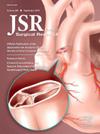Optimizing Morbidity and Mortality Conference for Education and Quality Improvement
IF 1.8
3区 医学
Q2 SURGERY
引用次数: 0
Abstract
Introduction
Despite their long history, morbidity and mortality conferences (MMC) lack standardization and have not been shown to change behavior or improve outcomes. Our trauma center developed a database to record events discussed at acute care surgery MMC with the aim of improving the integration of MMC for education and quality improvement.
Methods
From May 2020 to November 2022, surgical trainees documented patient demographics, procedures performed, and details of adverse outcomes in a REDCap database. Using the institutionally developed Quality of Care Score (QCS) to standardize event reporting, trainees scored each event before MMC and consensus QCS was assigned after conference. We describe events presented at MMC and compare trainee to consensus scores.
Results
We included data from 679 patients who experienced 916 reported events. Sixty-five percent of the cohort was admitted for trauma. Exploratory laparotomy (31%) and incision and soft tissue debridement (15%) were the most common procedures performed. Comparison of trainee versus consensus QCS revealed identical scores in 84% of cases. Consensus scores were lower than trainee scores 12% of the time and higher 3% of the time. While patient deaths comprised the majority of reported events over the study period (47%), they made up a decreasing proportion of overall events reported over time.
Conclusions
Through the development of a standardized reporting platform for patient events and use of a numeric grading system, our program facilitates rapid quantitative analysis of surgical adverse events using a platform that can be easily adapted to different practice environments and systems. Discordance between trainee and consensus QCS highlights opportunities for trainee education about standards of care and disease processes, and ongoing data collection facilitates rapid identification of quality concerns.
优化发病率和死亡率教育和质量改进会议
尽管历史悠久,但发病率和死亡率会议(MMC)缺乏标准化,并没有显示出改变行为或改善结果。我们的创伤中心开发了一个数据库来记录急诊外科MMC讨论的事件,目的是改善MMC的教育和质量提高的整合。方法:从2020年5月到2022年11月,外科培训生在REDCap数据库中记录了患者的人口统计数据、所做的手术和不良后果的详细信息。使用机构开发的护理质量评分(QCS)来规范事件报告,学员在MMC之前对每个事件进行评分,会议后分配共识QCS。我们描述了在MMC上出现的事件,并将受训者与共识分数进行比较。结果我们纳入了679例患者的数据,这些患者经历了916例报告的事件。65%的人因创伤入院。剖腹探查术(31%)和切口及软组织清创术(15%)是最常见的手术方法。学员与共识QCS的比较显示84%的病例得分相同。在12%的时间里,共识得分低于实习生得分,在3%的时间里,共识得分高于实习生得分。虽然患者死亡占研究期间报告事件的大部分(47%),但随着时间的推移,它们在报告的总体事件中所占的比例在下降。通过开发患者事件的标准化报告平台和使用数字分级系统,我们的项目使用一个可以轻松适应不同实践环境和系统的平台,促进了手术不良事件的快速定量分析。培训生与共识QCS之间的不一致突出了培训生关于护理标准和疾病过程的教育机会,并且正在进行的数据收集有助于快速识别质量问题。
本文章由计算机程序翻译,如有差异,请以英文原文为准。
求助全文
约1分钟内获得全文
求助全文
来源期刊
CiteScore
3.90
自引率
4.50%
发文量
627
审稿时长
138 days
期刊介绍:
The Journal of Surgical Research: Clinical and Laboratory Investigation publishes original articles concerned with clinical and laboratory investigations relevant to surgical practice and teaching. The journal emphasizes reports of clinical investigations or fundamental research bearing directly on surgical management that will be of general interest to a broad range of surgeons and surgical researchers. The articles presented need not have been the products of surgeons or of surgical laboratories.
The Journal of Surgical Research also features review articles and special articles relating to educational, research, or social issues of interest to the academic surgical community.

 求助内容:
求助内容: 应助结果提醒方式:
应助结果提醒方式:


